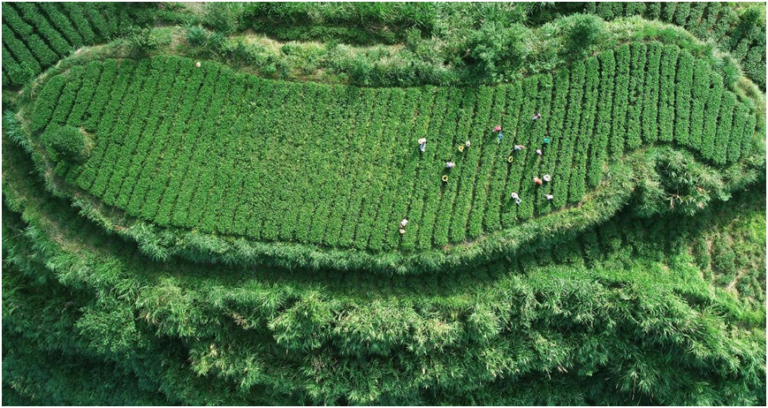
By Song Yiran, People’s Daily
The Food and Agriculture Organization of the United Nations (FAO) recently designated three sites in China as Globally Important Agricultural Heritage Systems (GIAHS), bringing the total number of GIAHS in China to 18, the highest in the world.
The three sites, which include an ancient tea-producing area in Anxicounty, east China’s Fujian province; a nomadic livestock-rearing region in Chifengcity, north China’s Inner Mongolia autonomous region; and a rain-fed stone terrace farming system in Shexiancounty, north China’s Hebei province, were recognized as GIAHS by the FAO through online an investigation, the first in the history of the GIAHS program.
Agricultural heritage is a kind of living production system that is still playing a role in the field of production. China has a long history of splendid agricultural civilization, and farmers in the country have created rich agricultural heritage during long-term production practice.
Early in 2005, the FAOclassified a symbiotic rice-fish culture system in Qingtiancounty, Lishui city of east China’s Zhejiang province, as one of the first GIAHS.
Starting with protection of the symbiotic rice-fish culture system, China has steadily advanced the conservation of its important agricultural heritage, becoming an active participant in, important promoter of and major contributor to the GIAHS Initiative.
In 2012, the country took the lead in the world in recognizing national-level agricultural heritage sites; in 2015, China issued the world’s first administrative measures for important agricultural heritage; and since 2016, work related to agricultural heritage protection has appeared in China’s “No.1 central document”, the first policy statement released by the central authorities each year, for many times and has been incorporated into the country’s law on the promotion of rural vitalization.
China’s rich agricultural heritage is a vivid reflection of its agricultural development philosophy which emphasizes adapting agricultural activities to local conditions following the laws of nature, and ecological sustainability.
The three newly designated GIAHS sites in China all adopt eco-friendly practices and play vital roles in maintaining unique biodiversity and ecosystems.
The ancient tea-producing area in Anxicountyare renowned for its ecological functions including water and soil conservation and microclimate regulation.
The ArHorqin grassland nomadic systemin Chifengcity is a global model of sustainable animal husbandry and fragile grazing lands management. By constantly moving their grazing grounds, local herdspeople ensure the protection of vegetation and rational utilization of water resources.
Therain-fed stone terrace farming system in Shexiancounty has preserved abundant varieties of traditional crops and eco-friendly farming techniques, guaranteeing the development of agricultural production in harsh conditions in mountainous areas over the past centuries.
China believes that lucid waters and lush mountains are invaluable assets.
“Agricultural heritage is traditional agriculture, rather than backward agriculture. As we protect agricultural heritage, we are not protecting backward techniques from the past, but discovering valuable practices and knowledge for the purpose of creating a better future,” said Min Qingwen, chairman of the expert committee for GIAHS under China’s Ministry of Agriculture and Rural Affairs (MARA).
“The recognition of GIAHS by FAO plays an important role in improving the visibility of the areas where GIAHS sites are located, promoting the development of local characteristic products, as well as protecting local biodiversity, natural landscape, and agricultural culture,” Min pointed out.
In recent years, the symbiotic rice-fish culture system in Qingtiancounty has brought the locality an annual output of over 200 million yuan ($29.8 million), increasing farmers’ income while effectively propelling rural vitalization of the county.
The experience and wisdom in China’s agricultural heritage have also benefited many other countries. At the beginning of the 21st century, Nigeria introduced the method of raising fish in paddy fields featured in the symbiotic rice-fish culture system in Qingtiancounty. With the help of Chinese experts, the country’s rice and tilapia outputs have almost doubled.
In 2014, the Chinese government and the FAO signed an agreement on GIAHS cooperation under the framework of South-South cooperation. Since then, China and the FAO have jointly held high-level training courses on GIAHS to share China’s experience in protecting agricultural heritage with trainees from all over the world.
Moreover, China’s experience in protecting and managing agricultural heritage is being spread to more countries and regions through channels including the Belt and Road Initiative.
Agricultural heritage is an important component of excellent traditional Chinese culture as well as the common wealth of humanity. As more people benefit from the essence of agricultural heritage, it’s believed that the “wisdom of China” will continue to play an important role in driving sustainable development of agriculture, poverty elimination, ecological conservation, and other fields.










